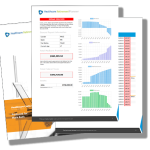Going through Medicare Donut Hole 2023 and you feel like you’re stuck in a labyrinth, trying to make sense of the puzzling twists and turns? If so, welcome to the world of Medicare Donut Hole 2023. Navigating through this seemingly complex maze can be daunting. What if I said there’s hope?
The good news is that understanding Medicare Part D’s coverage stages doesn’t have to feel like solving a Rubik’s cube. With a bit of guidance and patience, it all starts making sense.
Intrigued? Stick around as we embark on an insightful journey together—through initial coverage stage, over into the dreaded donut hole phase, then out onto greener pastures: catastrophic coverage. We’ll dissect how these phases impact your pocketbook and uncover strategies for managing prescription drug costs effectively.
So, you get it; knowledge truly matters.
Understanding the Medicare Donut Hole in 2023
The term “Medicare donut hole” might sound like a sweet treat, but it’s not as tasty when you realize it refers to a coverage gap stage within your prescription drug plan. In this article, we’ll explore the intricacies of the Medicare Part D donut hole.
The Role of Coverage Gap in Prescription Drug Costs
To understand how this affects out-of-pocket costs for prescription drugs under Medicare Part D plans, let’s first break down what happens when you hit that dreaded donut hole.
In 2023, after spending $4,660 on covered drugs (including what your plan pays), you’ll find yourself in this gap phase. But here’s some good news: since the ‘donut hole’ closed for all brand-name and generic drugs back in 2023 thanks to federal government initiatives; now individuals are responsible only for 25% of their drug costs during this period.
Changes to the Donut Hole Over Time
Over time legislative changes have made sure that more people get help with their high-cost medication by reducing these expenses. The Affordable Care Act has played an essential role here – working towards shrinking this coverage gap each year until it finally got rid of it completely.
This meant big savings on prescription drug costs especially for those who used costly brand-name or specialty medications – quite a relief considering ever-rising monthly premiums.
Navigating Through Different Stages of Medicare Part D Coverage
It’s important to know that there are different stages involved in a typical Medicare Part D plan: the initial coverage stage, the coverage gap (donut hole), and catastrophic coverage.
The limit to enter the donut hole is $4,660. Once you’ve spent $7,400 out-of-pocket on prescription costs in 2023, you exit this temporary limit and reach catastrophic coverage. This is where your drug plan starts to pick up most of the tab again.
How Deductibles Impact Your Coverage Stages
Back in 2023,
Key Takeaway:
When we talk about the ‘Medicare donut hole’, we’re pointing to a gap in your prescription drug coverage. This hiccup kicks in once you’ve shelled out $4,660 on approved medications and stops when you hit $7,400 in personal expenses during 2023. But here’s some good news – changes like those made by the Affordable Care Act mean that you only have to cover 25% of all drug costs while stuck inside this ‘donut hole’.
Navigating Through Different Stages of Medicare Part D Coverage
Medicare Part D coverage is like a multi-stage journey, with each stage having its own rules and costs. This trip begins with the initial coverage stage.
How Deductibles Impact Your Coverage Stages
The first stop on this trip is your yearly deductible. In 2023, it’s capped at $505. According to Medicare.gov, you start off paying out-of-pocket until you reach this amount.
You then enter the initial coverage phase where both you and your drug plan share the cost of covered drugs. The catch? You’re footing more of the bill than they are.
Moving along in our journey, after spending $4,660 (including what your plan pays), we hit an infamous speed bump – the donut hole or coverage gap phase. During this period, although it may seem as if costs have skyrocketed because your plan pay decreases substantially, there’s good news. Due to changes by federal government initiatives for drug coverage over time including inflation reduction measures, now individuals only cover 25% of their total prescription costs, whether generic drugs or brand-name ones during this period.
We finally get some relief once we’ve spent a whopping $7,400 out-of-pocket in 2023. Congratulations. We’ve reached catastrophic coverage territory. Now all those high prescription drug plans payments feel worth it because most people will see significantly reduced costs. This is a point where your plan pays the majority of the cost for covered drugs.
It’s important to include monthly premiums in our calculations because these count towards reaching catastrophic coverage faster. By keeping track of total drug spending and understanding when you transition between stages, we can help make this Medicare Part D journey a bit smoother.
In all, navigating through different stages requires understanding their impacts on out-of-pocket costs and staying vigilant about transitions. The trip may be bumpy at times but with knowledge comes power – or in this case, potential savings.
Key Takeaway:
Think of Medicare Part D as a road trip with different stops. It kicks off with your deductible, then shifts to initial coverage where you split the drug cost with your plan but shoulder more load. Once you’ve shelled out $4,660, you hit the ‘donut hole’ or gap phase – even though it feels like costs skyrocket due to less help from your plan, in reality, you’re only picking up 25%.
Practical Strategies to Navigate through Medicare Donut Hole
Figuring out how to manage costs in the donut hole phase can feel like navigating a maze. Navigating the donut hole phase doesn’t have to be a solo journey; there are practical strategies that can help.
Utilizing Generic Drugs to Reduce Costs
The choice of drugs is critical when planning for the coverage gap phase. Opting for generic versions of brand-name drugs could significantly lower your prescription drug costs. This approach helps you manage out-of-pocket expenses effectively during the donut hole stage.
In fact, while in the donut hole, individuals only pay 25% of their drug costs – both for brand-name and generic medications. The key lies in finding comparable generics that serve as effective substitutes without compromising treatment quality or outcomes.
Tips:
- See if your medical professional can inform you if a less costly generic option will do the same job for you.
- Contact your plan provider about which drugs they cover under each stage – especially those covered during the gap period.
- Check with patient assistance programs; many pharmaceutical companies offer them.
Aiming For Catastrophic Coverage Faster
Catastrophic coverage is an overlooked yet significant aspect when considering total drug spending on Medicare Part D plans. Once your out-of-pocket cost reaches $7,400 (in 2023), catastrophic coverage kicks in.
This means that beyond this point, all further medication purchases will have dramatically reduced copayments or coinsurance rates. Now isn’t that something worth aiming for?
So, what’s the strategy? Spend wisely in your initial coverage and donut hole stages. Keep track of both covered drugs costs as well as generic drug prices. This way, you’ll reach catastrophic coverage faster without unnecessarily inflating out-of-pocket expenses.
So here’s the scoop: Be clever with your planning to make sure you’re sorted for meds, while also hitting that sweet spot quicker.
Key Takeaway:
Getting through the Medicare donut hole can be a challenge, but smart strategies can help. Use generic drugs to lower costs and manage expenses effectively during this stage. Aim for catastrophic coverage quicker by keeping track of drug prices and spending wisely in initial stages. It’s all about clever planning.
Understanding Changes and Updates to Medicare Donut Hole in 2023
The year 2023 brings some pivotal updates to the Medicare Part D donut hole, which could influence your out-of-pocket costs for prescription drugs. These changes are a result of various federal government initiatives aimed at improving drug coverage.
Impact of Inflation Reduction on Donut Hole
To address increasing healthcare expenses, various inflation reduction initiatives have been implemented in recent years. This approach has had noticeable effects on the limits and cost-sharing responsibilities associated with the Medicare donut hole.
The good tidings are that, since 2023, the same amount of expense-splitting applies to both branded and generic medications during this phase. Specifically, individuals are now responsible for only 25% of their drug costs when they hit this stage.
This change came about due largely to legislative action by our federal government designed specifically to close the infamous donut hole. But what does it mean for you?
To put it simply: less financial strain. If you’re someone who regularly uses prescription medication (and let’s face it—who isn’t these days?), then hitting that coverage gap can be like falling into quicksand…with your wallet first. With these new rules though, you won’t sink quite as deep into those murky waters because much more manageable out-of-pocket expenses will give you a fighting chance.
A key part of understanding these changes also involves knowing how monthly premiums will look moving forward in 2023. Thankfully, thanks again partly due to ongoing efforts from Uncle Sam himself (a.k.a., the federal government), those changes are also looking positive.
Navigating through the intricacies of Medicare Part D can be like trying to make your way out of a convoluted labyrinth. Fortunately, aid is available both in the digital realm and beyond for those who require it.
Key Takeaway:
Get ready for a shakeup in 2023 as Medicare Part D’s donut hole sees big changes, all thanks to Uncle Sam. Expect less financial stress because both brand-name and generic drugs will now only cost you 25% during this phase. Navigating these changes might feel like wandering through a maze, but help is just around the corner.
Comparing Medicare Donut Hole in 2023 with Previous Years
The concept of the Medicare donut hole, or coverage gap, has evolved significantly over time. It’s crucial to compare its state in 2023 with previous years to understand these changes.
In the past, entering the donut hole coverage gap stage meant a temporary limit on what your drug plan would cover for prescription drugs. You’d have to shoulder more costs until you reached catastrophic coverage.
Evaluating Out-of-Pocket Costs in Different Years
To give this some context, let’s use our family members as an example. Uncle Bob had significant out-of-pocket expenses during his donut hole phase back in 2010 when he was responsible for all of his medication costs.
Funny enough though, Aunt Susan entered her donut hole period just last year and only paid 25% for both brand-name and generic drugs thanks to recent reforms like inflation reduction measures by the federal government. That’s quite a difference from Uncle Bob’s time.
Analyzing The Evolution Of The Medicare Donut Hole
A pivotal change came about due to legislative actions such as those within the Affordable Care Act (ACA). Good news folks – by law since 2023 – voila. – we saw that infamous hole closed completely.
By introducing lower prescription costs and capping out-of-pocket expenses, the law in 2023 has made medications more accessible to beneficiaries. It’s like trading in your old rusty car (that guzzles gas) for a brand-new fuel-efficient model.
Comparing these changes to 2023, the coverage gap has continued to shrink each year due to legislative updates and discount programs.
In fact, entering the donut hole now doesn’t feel as daunting anymore. The limit before you enter this stage is $4,660 while the threshold before reaching catastrophic coverage is at $7,400.
The Takeaway?
Looking at Medicare’s notorious donut hole in 2023, it’s obvious that big strides have been taken compared to past years. The coverage
Key Takeaway:
By comparing the Medicare donut hole in 2023 with previous years, it’s clear that there have been big changes. No longer does entering this coverage gap mean sky-high costs for prescription drugs. Thanks to reforms like the ACA and other legislative actions, out-of-pocket expenses are capped and medications are more affordable than ever before.
FAQs in Relation to Medicare Donut Hole 2023
Is the donut hole in Medicare going away?
The donut hole officially closed in 2023, meaning beneficiaries now pay no more than 25% of their drug costs during this phase.
What will the Medicare donut hole be in 2024?
We can’t predict exact figures for 2024 yet. But expect slight adjustments to limits and out-of-pocket thresholds due to inflation changes.
What is the catastrophic cap for Medicare 2023?
In 2023, once you’ve spent $7,400 out-of-pocket on covered drugs, you’ll leave the coverage gap and enter catastrophic coverage.
What is the out-of-pocket limit for Medicare Part D in 2023?
The maximum out-of-pocket threshold before entering catastrophic coverage under a Part D plan in 2023 is set at $7,400.
Table of Contents:
- Understanding the Medicare Donut Hole in 2023
- Navigating Through Different Stages of Medicare Part D Coverage
- Navigating Through Different Stages of Medicare Part D Coverage
- Practical Strategies to Navigate through Medicare Donut Hole
- Understanding Changes and Updates to Medicare Donut Hole in 2023
- Comparing Medicare Donut Hole in 2023 with Previous Years
- FAQs in Relation to Medicare Donut Hole 2023




